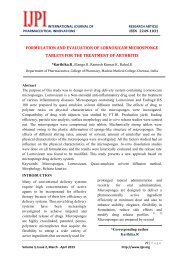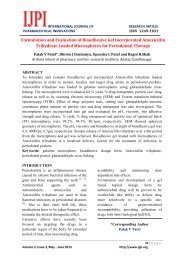MORPHO ANATOMICAL STUDIES OF LEAVES OF Urena ... - IJPI
MORPHO ANATOMICAL STUDIES OF LEAVES OF Urena ... - IJPI
MORPHO ANATOMICAL STUDIES OF LEAVES OF Urena ... - IJPI
Create successful ePaper yourself
Turn your PDF publications into a flip-book with our unique Google optimized e-Paper software.
INTERNATIONAL JOURNAL <strong>OF</strong><br />
RESEARCH ARTICLE<br />
PHARMACEUTICAL INNOVATIONS ISSN 2249-1031<br />
Sc:- Sclerenchyma, LB:-Lateral Bundle,<br />
Ph:-Pholem, Tr:-Trichome, X:-Xylem,<br />
Pa:-Parenchyma, MB:-Median Bundle<br />
Venation pattern<br />
The vein-lets are prominent, forming,<br />
distinct, polygonal. The vein-terminations<br />
are distinct, short thick and unbranched;<br />
the islets are random in orientation (Fig<br />
6A). Along the vein calcium oxalate<br />
druses are located in regular uniseriate<br />
row. The crystals are spherical, spiny<br />
bodies of 30 μm in diameter (Fig.6B).<br />
type and are long, narrow, tapering<br />
towards the tip. The cell walls are fairly<br />
thick and smooth. The trichomes have no<br />
cell inclusions with 1.05 mm long and 30<br />
µm in thickness.<br />
Fig 6. Venation pattern of <strong>Urena</strong> lobata<br />
Linn leaf<br />
A:- Vein islets and vein termination,<br />
B:- Crystals along the vein under<br />
polarized light microscope.<br />
Cr:- Crystals, VI:- Vein Islets. VT:-<br />
Vein Terminology<br />
Powder Analysis<br />
The leaf powder of <strong>Urena</strong> lobata Linn was<br />
greenish in colour, with punget odour and<br />
characteristic taste. Powder analysis<br />
observation cited that Non glandular<br />
trichomes and A cluster of trichomes (Fig7<br />
A&B). Epidermal trichomes are presented<br />
as unicellular and unbranched in the<br />
powder .The trichomes are non glandular<br />
Volume 3, Issue 1, Jan. − Feb. 2013<br />
7. Powder microscopy of trichomes<br />
A. Non glandular Trichomes, B. Cluster<br />
of Trichomes<br />
Fragments of fibers which are thick,<br />
narrow and wide (Fig 8 A, B&C).<br />
Parenchyma cells are wide and narrow,<br />
elongated, rectangular and thick walled<br />
seen in isolated condition. They have thick<br />
cellulose walls and wide circular simple<br />
pits. The cells are 250-350 µm long and<br />
30-70 µm wide. Fibers (xylem) widely<br />
spread in the powder. They are long and<br />
thin in the middle and gradually tapering<br />
the ends. The walls are thick and lignified<br />
and the pits on the walls are not evident.<br />
Some of the fibers are narrow and others<br />
are wide<br />
27 | P a g e<br />
http://www.ijpi.org
















